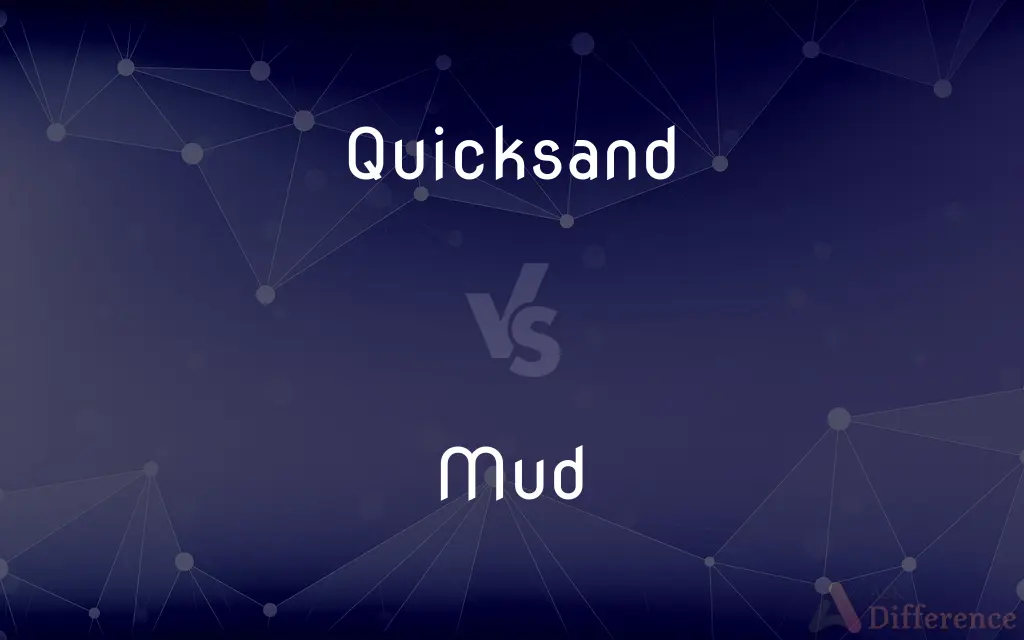Quicksand vs. Mud — What's the Difference?
By Tayyaba Rehman — Updated on October 25, 2023
Quicksand is a saturated mix of sand, water, and clay with a pudding-like consistency; mud is a mixture of water and soil, dirt, or silt.

Difference Between Quicksand and Mud
Table of Contents
ADVERTISEMENT
Key Differences
Quicksand and mud both involve mixtures of earth materials and water, yet they have distinct characteristics. Quicksand is often depicted in films as a perilous trap; it's formed when water saturates loose sand, creating a semi-liquid suspension. Mud, on the other hand, is more common and refers to wet, soft earth or ground resulting from a combination of dirt and water.
Despite their differences, both quicksand and mud can be hazardous in specific contexts. While quicksand can cause someone to sink if they panic or struggle, its real danger is often exaggerated. Mud, depending on its depth and viscosity, can make travel difficult, clog machinery, or lead to slips and falls.
The origins of quicksand and mud can be varied. Quicksand forms in areas with underground water sources like springs or in areas where water cannot escape easily, making the sand saturated. Mud forms after rain or near water sources when the earth gets wet and combines with water.
In popular culture, quicksand is often portrayed as a deadly pit swallowing its victims, but in reality, humans can't completely sink due to their buoyancy. Mud, while not as sensationalized, can still play pivotal roles in stories, often setting scenes of struggle, muddied appearances, or farming tales.
Both quicksand and mud hold metaphorical meanings too. Quicksand can symbolize a situation from which it's hard to escape, while mud might represent dirtiness, slinging accusations, or being "stuck" in a situation.
ADVERTISEMENT
Comparison Chart
Composition
Sand, water, and often clay
Water and soil, dirt, or silt
Consistency
Pudding-like, semi-liquid
Varies from watery to thick paste
Formation
Areas with underground water, often near springs
Typically after rain or near water sources
Cultural Symbolism
Danger, hard to escape situations
Dirtiness, accusations, being "stuck"
Buoyancy
Humans can float due to body density
Depending on depth, can be hard to traverse
Compare with Definitions
Quicksand
Quicksand is a saturated mixture of sand, clay, and water.
While hiking near the river, he almost stepped into quicksand.
Mud
Mud is a mixture of water and any combination of soil, silt, and clay.
After the rain, the backyard was full of mud.
Quicksand
Quicksand can trap objects or persons due to its viscosity.
The explorer moved slowly, fearing the presence of quicksand.
Mud
Mud is wet, soft earth.
Children love to play in the mud after a heavy downpour.
Quicksand
Quicksand becomes denser with added pressure, making extraction difficult.
She knew that struggling would only make the quicksand grip tighter.
Mud
Mud can be used for therapeutic purposes in certain cultures.
She went to a spa that offered mud baths for relaxation.
Quicksand
Quicksand is a colloid hydrogel consisting mainly of fine granular material.
She found herself stuck in quicksand during her forest expedition.
Mud
Mud often symbolizes uncleanliness or messy situations.
He tried to stay out of the mud-slinging during the debate.
Quicksand
Quicksand is often associated with danger in popular culture.
The adventure movie had a thrilling scene involving quicksand.
Mud
Mud is soil, loam, silt or clay mixed with water. It usually forms after rainfall or near water sources.
Quicksand
Quicksand is a colloid consisting of fine granular material (such as sand, silt or clay) and water. Quicksand forms in saturated loose sand when the sand is suddenly agitated.
Mud
A computer-based text or virtual reality game which several players play at the same time, interacting with each other as well as with characters controlled by the computer.
Quicksand
Loose wet sand that yields easily to pressure and sucks in anything resting on or falling into it
It's best to travel with a local as there are quicksands
Mud
A computer program, usually running over the internet, that allows multiple users to participate in virtual-reality role-playing games.
Quicksand
Sand that is mixed with water in a collected mass and yields easily to pressure so that objects on its surface tend to sink and become engulfed.
Mud
Wet, sticky, soft earth, as on the banks of a river.
Quicksand
Often quicksands A place or situation into which entry can be swift and sudden but from which extrication can be difficult or impossible
"This theory of the future entrapped [them] in the quicksands of Vietnam" (Arthur M. Schlesinger, Jr.).
Mud
(Slang) Wet plaster, mortar, or cement.
Quicksand
Wet sand that appears firm but in which things readily sink, often found near rivers or coasts.
My feet were firmly lodged in the quicksand, and the more I struggled the more I sank into it.
Mud
Slanderous or defamatory charges or comments
Slinging mud at his opponent.
Quicksand
Anything that pulls one down or buries one metaphorically
The quicksands of youth...
Mud
To cover or spatter with or as if with mud.
Quicksand
Sand easily moved or readily yielding to pressure; especially, a deep mass of loose or moving sand mixed with water, sometimes found at the mouth of a river or along some coasts, and very dangerous, from the difficulty of extricating a person who begins sinking into it.
Life hath quicksands, - Life hath snares!
Mud
A mixture of water and soil or fine grained sediment.
Quicksand
A treacherous situation that tends to entrap and destroy
Mud
A plaster-like mixture used to texture or smooth drywall.
Quicksand
A pit filled with loose wet sand into which objects are sucked down
Mud
(construction industry slang) Wet concrete as it is being mixed, delivered and poured.
Mud
(figuratively) Willfully abusive, even slanderous remarks or claims, notably between political opponents.
The campaign issues got lost in all the mud from both parties.
Mud
(slang) Money, dough, especially when proceeding from dirty business.
Mud
Stool that is exposed as a result of anal sex.
Mud
(geology) A particle less than 62.5 microns in diameter, following the Wentworth scale
Mud
A black person.
Mud
Drilling fluid.
Mud
(slang) Coffee.
Mud
(transitive) To make muddy or dirty; to apply mud to (something).
Mud
(transitive) To make turbid.
Mud
(intransitive) To go under the mud, as an eel does.
Mud
To participate in a MUD or multi-user dungeon.
Mud
Earth and water mixed so as to be soft and adhesive.
Mud
To bury in mud.
Mud
To make muddy or turbid.
Mud
Water soaked soil; soft wet earth
Mud
Slanderous remarks or charges
Mud
Soil with mud, muck, or mire;
The child mucked up his shirt while playing ball in the garden
Mud
Plaster with mud
Mud
Mud can cause slips or hinder movement.
The hikers had difficulty trekking due to the thick mud.
Common Curiosities
What causes Mud to form?
Mud forms when water combines with soil, dirt, or silt.
Are there benefits to Mud?
Yes, mud has therapeutic uses, and certain cultures use it for healing or relaxation purposes.
Is Mud only a combination of water and soil?
Primarily, but it can also include silt and clay.
Can Mud be dried out?
Yes, when exposed to the sun or air for extended periods, mud can dry and harden.
What's the symbolic meaning of Quicksand in literature?
It often symbolizes perilous situations that are hard to escape from.
Why does Quicksand trap objects?
Due to its viscosity and the fact that it becomes denser with added pressure.
Is Quicksand as dangerous as shown in movies?
No, while quicksand can trap, it's unlikely to swallow someone whole due to human buoyancy.
What is Quicksand made of?
Quicksand is primarily a mixture of sand, water, and often clay.
How does Mud affect transportation?
It can make surfaces slippery, hindering movement and potentially causing vehicles to get stuck.
How is Mud used in construction?
Mud can be used as a binding material, in making bricks, or in certain types of natural construction.
Can animals also get trapped in Quicksand?
Yes, animals can get trapped, especially if they panic or struggle.
Can Mud be beneficial for the skin?
Yes, certain types of mud are used in skincare for their mineral content and exfoliating properties.
How can one escape from Quicksand?
Move slowly, avoid panicking, and try to lean backward to increase buoyancy.
Does Quicksand exist worldwide?
Yes, quicksand can be found in various places around the world, especially near underground water sources.
Are there different types of Quicksand?
The basic composition is similar, but the density and viscosity can vary based on sand and water content.
Share Your Discovery

Previous Comparison
Enteral vs. Parenteral
Next Comparison
Subject vs. ObjectAuthor Spotlight
Written by
Tayyaba RehmanTayyaba Rehman is a distinguished writer, currently serving as a primary contributor to askdifference.com. As a researcher in semantics and etymology, Tayyaba's passion for the complexity of languages and their distinctions has found a perfect home on the platform. Tayyaba delves into the intricacies of language, distinguishing between commonly confused words and phrases, thereby providing clarity for readers worldwide.














































